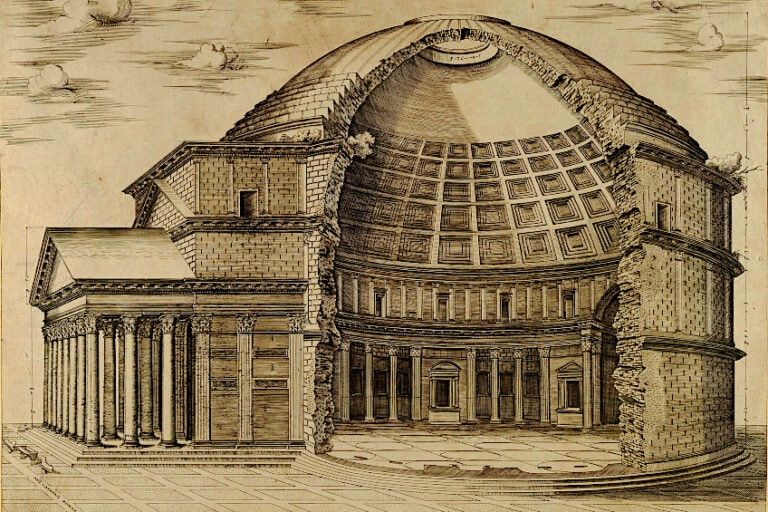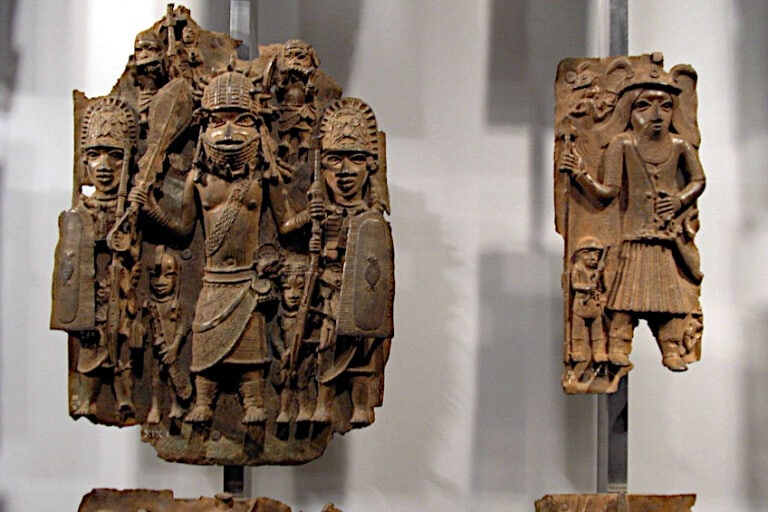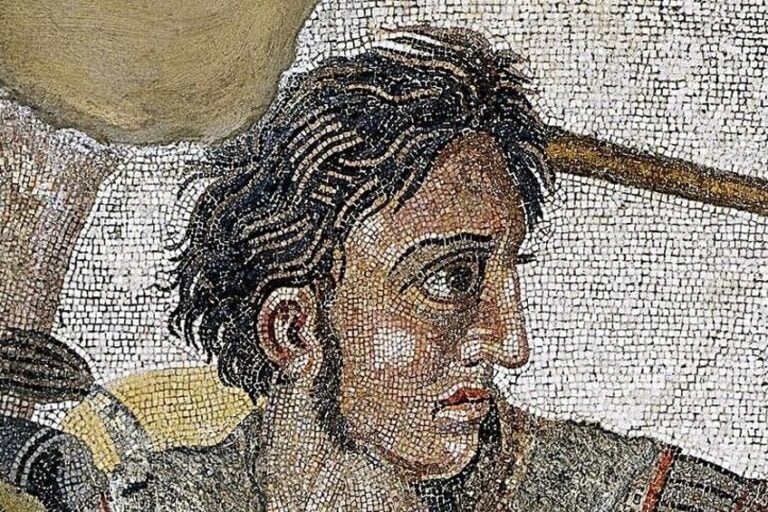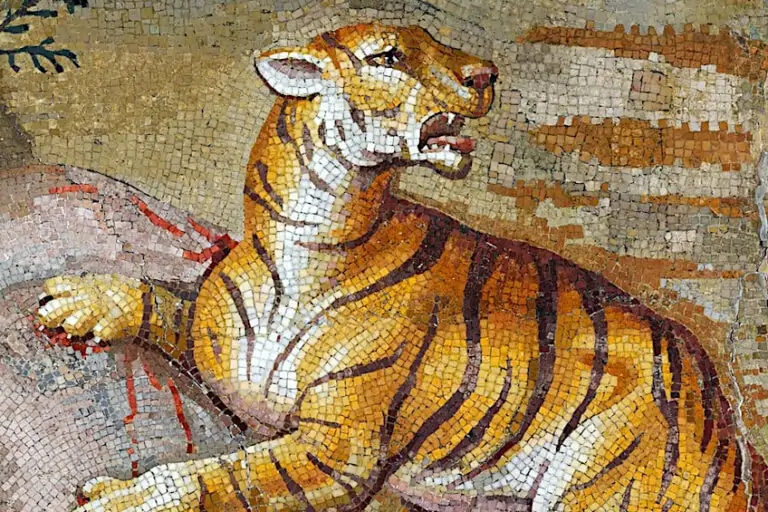Biblical Artifacts – The History of Famous Religious Artifacts
Inspiration comes from many places, whether it be from the work of others, the world around us, or our faith. Many people of the ancient world found artistic inspiration in their faith, and as a result, there have been many monuments, paintings, and structures resulting from their adherence to and study of their faith. One of the most prominent examples of this phenomenon is artifacts relating to the three major Abrahamic religions. These religious artifacts can be found all over the world and speak volumes to the dedication these people had to their faith. That being said, here are a few of the most interesting biblical artifacts found to date and what they’re intended to convey.
Famous Biblical Artifacts
Biblical artifacts can be found the world over, and all of them have been linked to milestones in religious history. Bible artifacts are fairly few and far between so finding them tends to be a pretty big deal in both historical and religious circles. Below are a few of the most prominent bible artifacts ever found, as well as what significance they bear to historical and religious scholars.
 A Family Bible (1859); David Ball, CC BY-SA 3.0, via Wikimedia Commons
A Family Bible (1859); David Ball, CC BY-SA 3.0, via Wikimedia Commons
The Lion and Calf Bowl (3300 – 2900 BCE)
| Artist | Unknown |
| Date Created | 3300 – 2900 BCE |
| Medium | Crystalline calcium-copper tetrasilicate |
| Dimensions (d) | 8.9 |
| Location of Discovery | Ancient Mesopotamia (Iran) |
| Current Location | Penn Museum, Pennsylvania, United States |
If you’re in the mood for an even older artifact with biblical themes we think you’ll enjoy the Lion and Calf bowl. The bowl is from Southern Mesopotamia and is believed to have been made sometime between 3300 and 2900 BCE. The marking on the bowl is related to Isaiah’s prophecy of peace which reads “the wolf shall dwell in the lamb; the leopard shall lie down with the kid and the calf and the lion at the fasting will dwell together”. All of the animals depicted on the circumference of the bowl (sheep and lions) are depicted lying down in front of one another. They are all laying down in front of a bundle of reeds, in the same stylization that can be found on the famous Ziggurat of Anu.
Anu is among the oldest of all the ancient Sumerian gods, making this artifact quite the find from both a historical and artistic perspective.
Noah’s Great Ark (2977 BCE)
| Artist | Noah (mythical/alleged constructor) |
| Date Created | 2977 BCE |
| Medium | Cypress wood |
| Dimensions (m) | 450 x 75 x 45 (theoretically) |
| Location of Discovery | N/A |
| Current Location | Unknown |
While we have covered religious artifacts that have been found and documented, we thought you’d like to hear about some artifacts whose location (and existence) have perplexed scholars and historians for years. One of these is the arc of Noah, which is said to have not only held two of every animal in existence but survived a world-ending flood for 150 days. According to scripture and other resources, the arch is believed to have been made of cypress wood, and once the flood had run its course it said that the arc came to rest at the mountains of Ararat, which is located at the intersection of the borders of Iran, Armenia, and Turkey. While most scholars believe that the arc is mythical, there are still those in search of it today.
 Exit from Noah’s Ark (c. 1410-1430) by Bedford Master; Bedford Master, Public domain, via Wikimedia Commons
Exit from Noah’s Ark (c. 1410-1430) by Bedford Master; Bedford Master, Public domain, via Wikimedia Commons
The Nile Boat (2000 – 1900 BCE)
| Artist | Unknown |
| Date Created | 2000 – 1900 BCE |
| Medium | Wood |
| Dimensions | 121.7 x 34.3 x 30.6 |
| Location of Discovery | The Middle Kingdom, Ancient Egypt, Northern Africa |
| Current Location | The Metropolitan Museum of Art, New York City, United States |
If there ever was a notable landmark in the bible, we reckon that the Nile would be the most recognizable of them all. One of the most notable mentions of the Nile River in the bible is in the story of Exodus, which tells of the enslavement of the Israelites and their subsequent departure from Egypt during ancient times. This model boat is believed to have been created around 2000-1900 BCE and is made of wood, plaster, and linen. The scene in the boat has eighteen rowers hard at work between the steersman at the rear of the boat and the pilot at the very front. The boat is currently set up to sail downstream, but scholars have indicated that it would have been capable of equipping a sail as well.
Models such as these were often placed in tombs to ensure a good trip to the afterlife.
 The Nile Boat (2000 – 1900 BCE); Walters Art Museum, Public domain, via Wikimedia Commons
The Nile Boat (2000 – 1900 BCE); Walters Art Museum, Public domain, via Wikimedia Commons
The Larsa Tablet (1821 BCE)
| Artist | Unknown |
| Date Created | 1821 BCE |
| Medium | Clay |
| Dimensions (in) | 6.37 x 3.13 |
| Location of Discovery | Ancient Mesopotamia (Iran) |
| Current Location | The British Museum, London, United Kingdom |
If you’re looking for truly ancient artifacts from the bible look no further than the Larsa tablet. Originating in Mesopotamia during the rule of King Rim-Sîn (around 1821 BCE) the tablet details the various rights undertaken in the temples of Mesopotamia during the time. These rights would take place during the month of Shabatu, equivalent to the modern-day Jewish practice of Shebat. These rights are all detailed in the Mesopotamian cuneiform script and lasted from day 15 until day 24 of the month. To make matters even more interesting, the biblical figure Abraham is believed to have called the region of Mesopotamia home, adding even more weight to the biblical inclinations of this tablet.
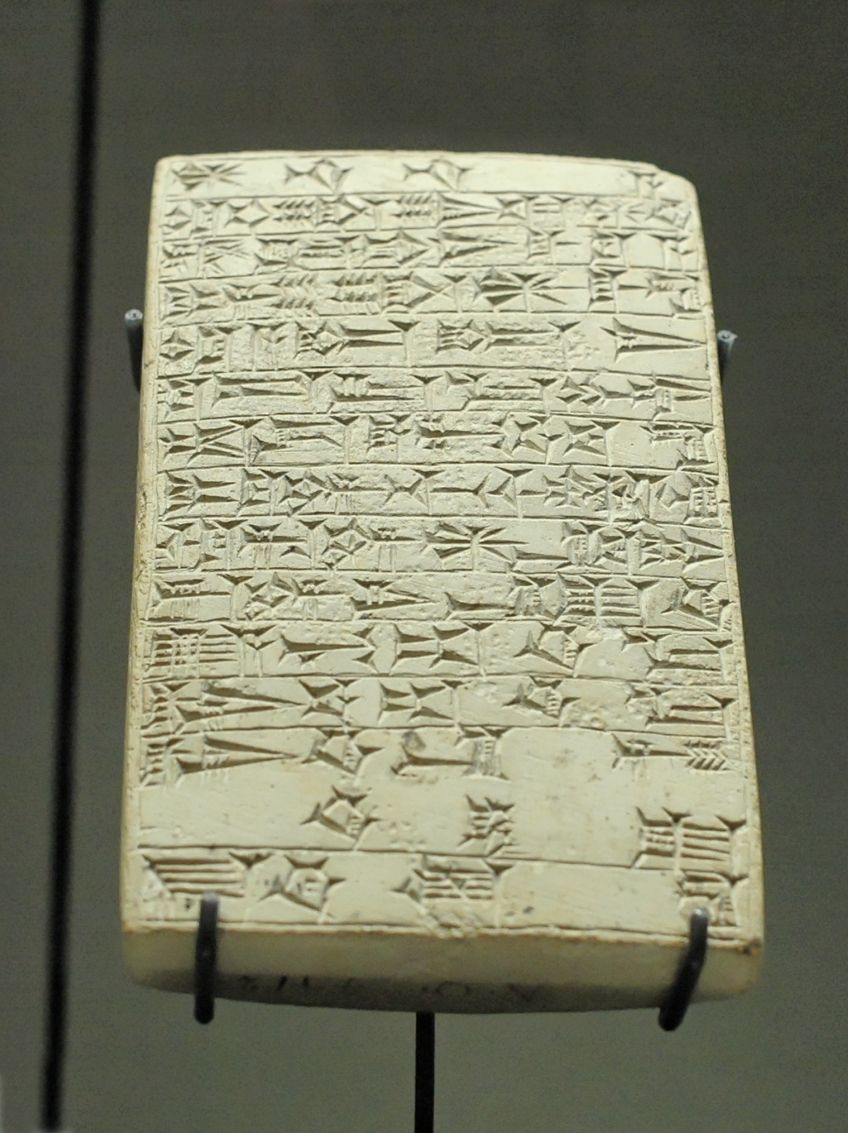 The Larsa Tablet (1821 BCE); Louvre Museum, Public domain, via Wikimedia Commons
The Larsa Tablet (1821 BCE); Louvre Museum, Public domain, via Wikimedia Commons
Relief Of Ark-Like Image (800 – 750 BCE)
| Artist | Unknown |
| Date Created | 800 – 750 BCE |
| Medium | Basalt |
| Dimensions | Unknown |
| Location of Discovery | Arslan Tash, Northern Syria |
| Current Location | The Bible Lands Museum, Jerusalem, Israel |
As the name suggests, this stone relief depicts the much-discussed arc of the covenant. According to the book of Exodus, the arch of the covenant was a large rectangular box with two poles located at its base that allowed it to be carried. This Basalt relief from Northern Syria depicts two men carrying the legendary arch with one hand each while carrying a bucket in their free hands. The presence of the bucket is believed to be an indication of the priesthood. If you’re a biblical history buff, you might have noticed something different about this depiction of the arch compared to others.
While the biblical description notes that the handles of the arch were at its base, the illustration on this tablet shows the arch having overhanging handles instead, a discrepancy that isn’t fully understood.
The Yahweh Sebaot Inscription (800 CE)
| Artist | Unknown |
| Date Created | 800 CE |
| Medium | Limestone |
| Dimensions (in) | 1 x 1 |
| Location of Discovery | Ancient Judah, Palestine |
| Current Location | Temple of Soleb, Sudan |
While this might not be quite as old as some of the other artifacts we’ve covered thus far, it is no less influential in our understanding of holy artifacts. This artifact was found in a burial cave in Judah and is believed to have been created around 800 BCE (give or take 50 years). The inscription is written in a script called Paleo Hebrew script. The holy artifact has an inscription that reads as follows: “Cursed be Hagaf son of Hagab by Yahweh Ṣebaot.”. In the Hebrew Bible, the phrase Yahweh appears around two hundred times and is believed to mean “lord of hosts”. This tablet and its inscription are believed to be one of the earliest non-biblical descriptions of the name by far.
The Quadrilingual Darius I Jar (486 BCE)
| Artist | Unknown |
| Date Created | 486 BCE |
| Medium | Calcite |
| Dimensions (cm) | 30 × 37 |
| Location of Discovery | Mausoleum at Halicarnassus, Caria, Turkey. |
| Current Location | The British Museum, London, United Kingdom |
While this jar is not referenced biblically it is one of many religious objects from its time period. The purpose of the jar isn’t known, but it has been theorized that it was used to contain water from the Nile River. The jar inscription is what has piqued the interest of both historians and biblical scholars alike as it displays praise of King Darius I in four languages. This is notably one more language than the Rosetta Stone. The specific languages illustrating praise to the once great King of Egypt are Elamite, Old Persian, Akkadian, and Egyptian. All of the languages (roughly) translate to “Darius the Great” and “King of Upper and Lower Egypt, lord of the two lands, Darius, living eternally, year 36.”
The pot is made of Persian calcite.
 The Quadrilingual Darius I Jar (486 BCE); Bukvoed, CC BY 4.0, via Wikimedia Commons
The Quadrilingual Darius I Jar (486 BCE); Bukvoed, CC BY 4.0, via Wikimedia Commons
The Jonah Sarcophagus (4th Century CE)
| Artist | Unknown |
| Date Created | 4th Century CE |
| Medium | Marble |
| Dimensions (cm) | 67 × 220 × 19 |
| Location of Discovery | St. Peter’s Cathedral while under construction |
| Current Location | The British Museum, London, United Kingdom |
If you’re in the mood for slightly more modern artifacts from the bible we highly recommend you check out the Jonah sarcophagus. This artifact is believed to have been created all the way back in the 4th century CE. As the name suggests, its themes center around the tale of Jonah from the bible, where he was swallowed by a great fish and lived to tell the tale. The depiction of the great sarcophagus illustrates three points in the famous tale. The left side shows Jonah being cast overboard into the mouth of the whale (or fish depending on your preference), while the right-hand side shows him washing ashore as god provides him with a plant to teach the sailor compassion. The intended message behind this is penance and resurrection.
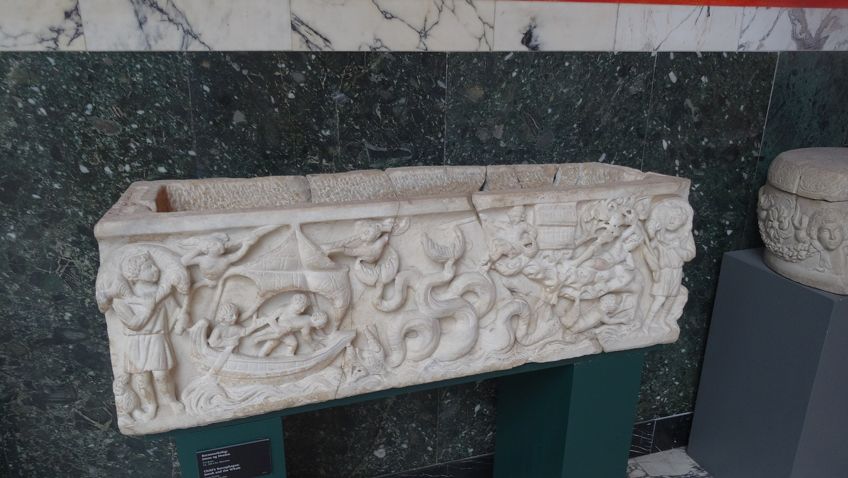 The Jonah Sarcophagus (4th Century CE); MumblerJamie, CC BY-SA 2.0, via Wikimedia Commons
The Jonah Sarcophagus (4th Century CE); MumblerJamie, CC BY-SA 2.0, via Wikimedia Commons
The Copper Dead Sea Scroll (3rd century BCE)
| Artist | Sect of Essenes |
| Date Created | 3rd century BCE |
| Medium | Copper |
| Dimensions (m) | 2.3 (h) |
| Location of Discovery | Khirbet Qumran, West Bank, Israel’s Qumran National Park |
| Current Location | Jordan Museum, Amman, Jordan |
Steering back to verified biblical artifacts we have the copper dead sea scroll. This one isn’t just unique because of the medium it’s inscribed on, but the nature of the information inscribed on it. Unlike the other scrolls, this one contains a sort of treasure map that supposedly leads to a number of valuable minerals like silver and gold! This scroll is one of many discovered in the caves lining the dead sea, but its treasure has never been officially found. Some scholars have debated as to whether these treasures ever really existed while others have theorized that these valuable items would have been hidden before the Roman invasion of the region.
While there is merit to both theories, we’ll likely never know the truth.
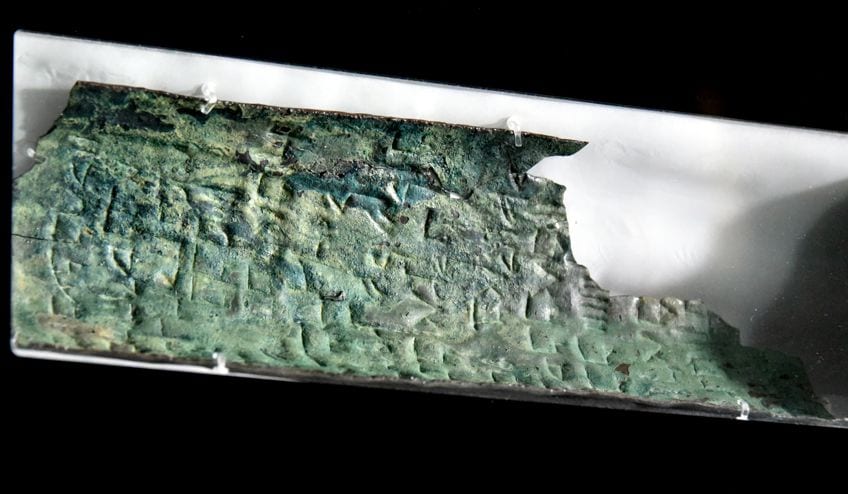 The Copper Dead Sea Scroll (3rd century BCE); Osama Shukir Muhammed Amin FRCP(Glasg), CC BY-SA 4.0, via Wikimedia Commons
The Copper Dead Sea Scroll (3rd century BCE); Osama Shukir Muhammed Amin FRCP(Glasg), CC BY-SA 4.0, via Wikimedia Commons
The Christogram Sarcophagus (330 – 340 CE)
| Artist | Unknown |
| Date Created | 330 – 340 CE |
| Medium | Marble |
| Dimensions (cm) | 208 X 208 X 76 |
| Location of Discovery | Rome, Italy |
| Current Location | The Bible Lands Museum, Jerusalem, Israel |
Another notable artifact from around the same period is the Christogram Sarcophagus. This artifact belonged to a Roman woman who passed away just after Constantine’s Edict of Toleration, a decree that allowed Christians to practice their faith freely in the region. This Sarcophagus was designed to represent her faith through the depiction of biblical scenes on its surfaces. That being said, all the surfaces of the sarcophagus have been adorned with some well-known biblical scenes such as Abraham nearly sacrificing his son, Jesus turning water into wine, and Jesus’s entry into Jerusalem. The Christogram in the center is one of the earliest known examples of this symbol and is essentially the first two letters of the Greek name for Christ represented as a seal.
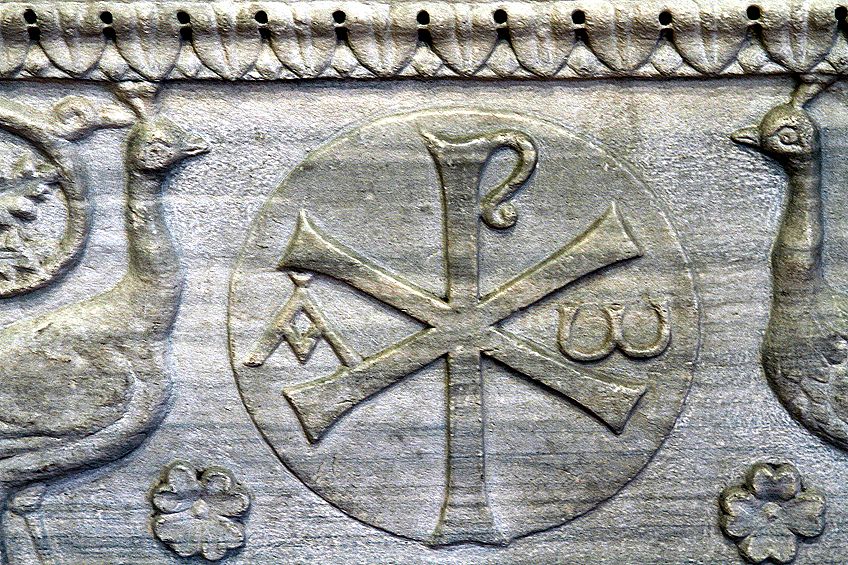 The Christogram Sarcophagus (330 – 340 CE); © José Luiz Bernardes Ribeiro
The Christogram Sarcophagus (330 – 340 CE); © José Luiz Bernardes Ribeiro
The Holy Grail ( 1st April 33 CE)
| Artist | Unknown |
| Date Created | 1st April 33 CE (proposed) |
| Medium | Red-brown agate and gold (theorized) |
| Dimensions (in) | 5.10 x 20.13 x 2.56 (theorized) |
| Location of Discovery | N/A |
| Current Location | Unknown |
Yet another biblical artifact that’s existence is up for debate is the Holy Grail. This artifact has been depicted in movies and other forms of media for years, including Arthurian legend. As far as biblical artifacts go, the Holy Grail is arguably one of the most well-known and sought-after considering that it is rumored to be the actual cup Christ drank from at the last supper. The cup is believed to have supernatural properties, but even the legitimacy of the last supper happening is up for debate by scholars these days. For the most part, even though there are rumors supporting the cup traveling Britain with Joseph of Arimathea, most scholars consider its existence and the rumors around it to be a myth.
 The Arming and Departure of the Knights (1891-94) woven by Morris & Co; Sir Edward Burne-Jones, overall design and figures; William Morris, overall design and execution; John Henry Dearle, flowers and decorative details., Public domain, via Wikimedia Commons
The Arming and Departure of the Knights (1891-94) woven by Morris & Co; Sir Edward Burne-Jones, overall design and figures; William Morris, overall design and execution; John Henry Dearle, flowers and decorative details., Public domain, via Wikimedia Commons
Now that you have a comprehensive list of biblical artifacts to peruse, as well as some information about their creation and link to the greater biblical tapestry, it’s time for you to get out there and put your newfound knowledge to the test. Biblical artifacts can be fascinating and can be found all over the world, so why not find out if there are any that you can see in your local museum?
Frequently Asked Questions
Is the Holy Grail in the Bible?
Movies like Indian Jones and Monty Python’s The Holy Grail depict the artifact as coveted and powerful. But is the Holy Grail in the bible though? Well, the last supper does mention a cup that Jesus shared with his disciples, but it does not mention the Holy Grail explicitly.
What Is the Oldest Biblical Artifact Ever Found?
While you might not find them on a common list of biblical artifacts, the Ketef Hinnom scrolls are the oldest biblical artifacts found to date. They date back to 600 BCE and contain priestly blessings used at the time from the Hebrew bible. They are considered to be one of the most important discoveries ever made.
Does Archaeology Disprove the Bible?
While this is a commonly asked question, it is not the fundamental point of the field of archaeology to disprove anything. Archaeology aims to tell us when, where, and how things unfolded in the ancient world, but it has never been the explicit aim of the field to determine why, as this would largely be speculation, which is a characteristic unbecoming of a scientific field.

I am deeply passionate about history and am constantly fascinated by the rich and complex stories of the past. As the editor-in-chief of learning-history.com, I have the opportunity to share this passion with a wide audience through the creation and distribution of engaging and informative content about historical events, persons, and cultures. Whether it’s through writing articles and blog posts or creating videos or podcasts, I strive to bring the past to life in a way that is both accurate and enjoyable. My expertise in history, combined with my strong writing and communication skills, allows me to effectively communicate complex historical concepts and make them accessible and interesting to a wide range of readers. I am truly grateful for the opportunity to share my love of history with others through my work on learning-history.com.


